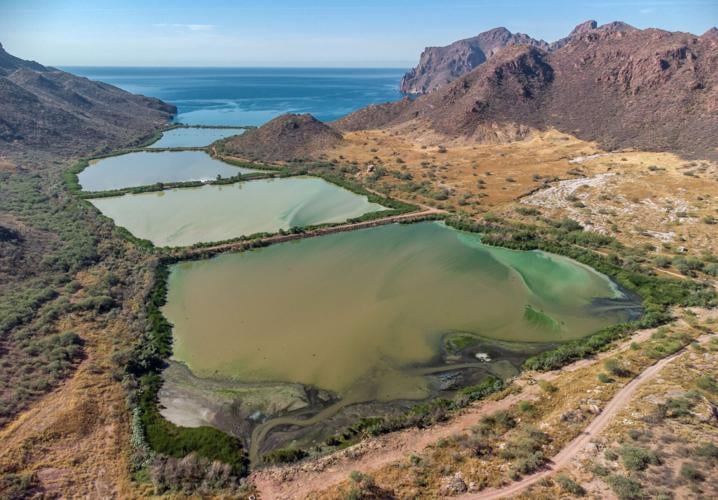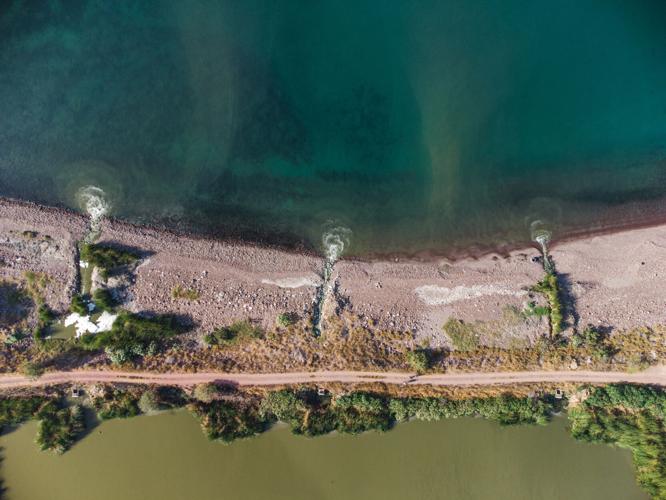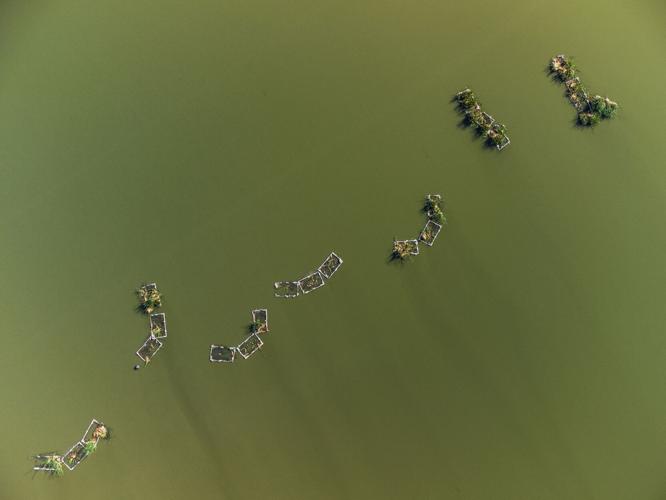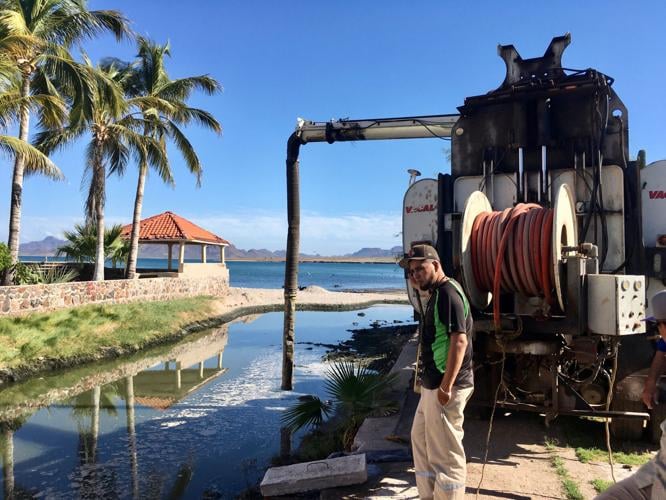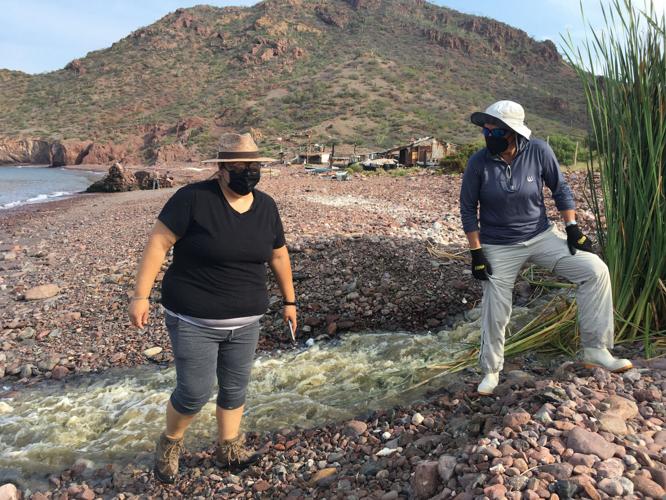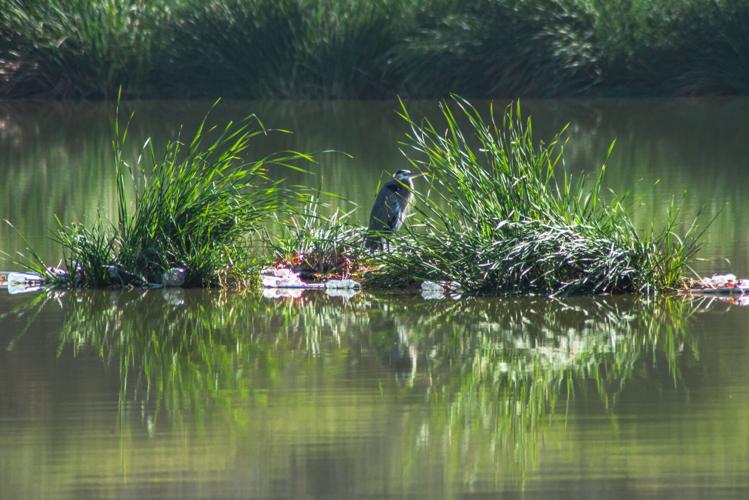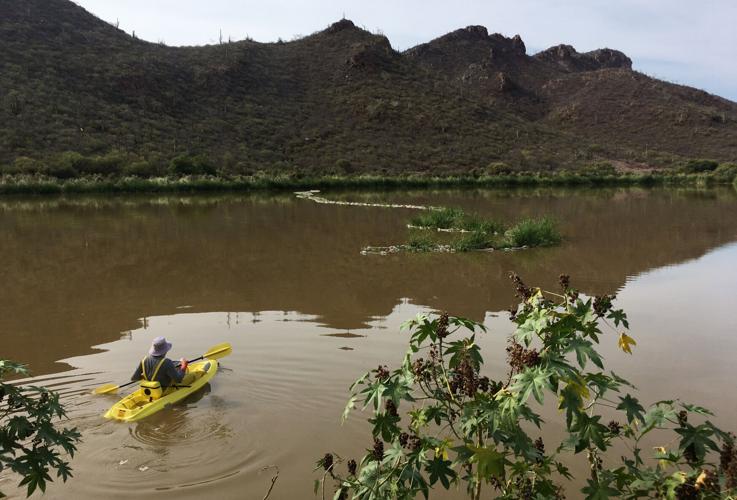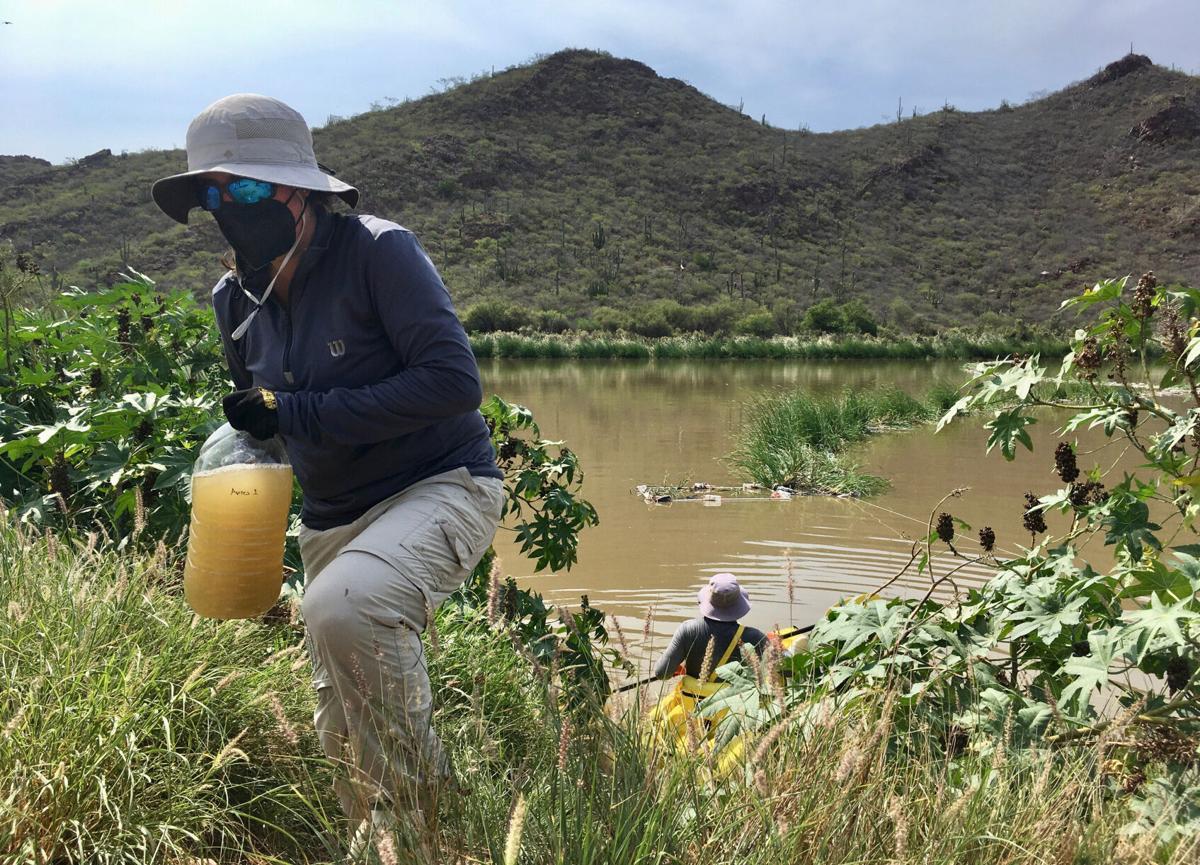Third of three stories
This project was produced in partnership with KJZZ's Fronteras Desk.
Listen to the two-part radio series at sewagecrisis.kjzz.org

This project was supported by the Pulitzer Center on Crisis Reporting.
GUAYMAS, Sonora — Sprawled at the water’s edge, Dr. Jaqueline García Hernández uses one leg to help stabilize a yellow kayak holding her colleague, Germán Leyva, who is floating precariously on a massive pond of minimally treated sewage.
A capsize would mean a nasty skin rash and potentially consuming dangerous levels of pathogens, said García Hernández, a biochemical engineer who runs the Environmental Sciences Lab at Guaymas’ Center for Investigation in Nutrition and Development, part of a network of federally supported laboratories.
On this sweltering August morning, part of the team’s floating aquaponics structure has gone adrift. García Hernández carefully hands over a heavy concrete anchor, which Levya balances between his legs before paddling toward the center of the pungent pond.
This low-budget floating wetland — constructed from recycled fishing nets stretched between PVC pipes, buoyed by empty plastic bottles — aims to improve the city’s neglected oxidation lagoon, which is supposed to treat wastewater through natural interaction of sunlight, algae, oxygen and bacteria.
It’s a modest start toward addressing a massive, multifaceted problem that’s undermining the health and quality of life of thousands in Guaymas: its obsolete and ineffective sewage treatment system.
“It’s common knowledge that (Guaymas) needs a water treatment plant,” or even more than one, said García Hernández, who completed her master’s and doctoral studies at the University of Arizona’s Department of Water, Soil and Environmental Sciences.
But in lieu of the state devoting resources to make that happen, García Hernández is doing what she can to mitigate the environmental impact of the failing oxidation lagoon, known as “La Salada.”
“I have faith in this wetland system,” she said. “But it has to be very well-designed.”

Guaymas’ oxidation lagoon, known as La Salada, was built to handle a wastewater flow of 200 liters per second. But currently, at least 350 liters of waste per second are flowing into the lagoons, said former CEA regional director Marco Antonio Ahumada. The wastewater should spend 36 hours in each pond so the remediation process has time to work. But with the extra volume, the wastewater moves too quickly through each pond to be cleaned properly, he said.
In partnership with University of Arizona’s David Walker in 2019, García Hernández applied for a grant to fund the project from the Consejo Nacional de Ciencia y Tecnología.
The proposal was rejected, and she’s also receiving no support from the state-operated water company, Comisión Estatal del Agua.
Funding or not, García Hernández said she had no choice but to continue with the experiment, once she saw that even a small pilot project improved the wastewater flowing from La Salada into the sea.
The pilot project’s 28-square-meter floating wetland — filled with flourishing cattail plants near the drains where wastewater exits the lagoon — resulted in a 32% average removal rate of fecal coliform bacteria in the summer 2019 testing session.
Fecal coliforms are the type of bacteria found in the intestines of warmblooded animals, and they’re often used as a proxy for fecal contamination in water.
In the winter testing session, when natural remediation processes tend to work more effectively, the researchers saw a 52% average removal rate, García Hernández said.
“Once we knew it worked, we had to do it” on a larger scale, she said.
Those removal rates still didn’t bring the water’s pathogen levels into compliance with the federal environmental standards, García Hernández said.
But she believes that with $100,000 in funding, and an overhaul of the lagoon’s design to maximize water contact with the wetlands, fecal coliform levels could eventually comply with those standards.
“It’s just a research project,” she said. “But it could work for Guaymas.”
Little planning for the long term
Tackling the ineffectiveness of La Salada is just one piece of a massive problem.
There’s also the neglected, obsolete sewer infrastructure throughout the city, as well as financial and operational challenges that former CEA leaders say are crippling the company’s effectiveness.
In separate interviews, former CEA directors — three former regional directors and one ex-state level director — painted a picture of a financially unstable company burdened by politics and a lack of long-term planning.
Three former regional directors — Marco Antonio Ahumada, Roberto Romano and Ivan Cruz — pointed to organizational challenges that must be addressed:
Limited local autonomy. Guaymas and San Carlos’ water and sewer companies are operated by the state, resulting in another layer of bureaucracy and reliance on distant politicians for major funding decisions.
Politics determining leadership. Regional and local CEA leaders are often replaced every three years with each mayoral election, making long-term planning impossible. State CEA leaders usually serve six years, coinciding with the governor’s term limit.
The CEA in Guaymas is financially unsustainable, with high payroll and energy expenses, too many users who don’t pay their water bills and a water rate that is one of the lowest in the state.
Other necessary reforms include the construction of modern wastewater treatment plants in Guaymas and San Carlos.
But former directors also spoke to simple changes that could dramatically alleviate the crisis, like establishing a regular maintenance schedule for existing infrastructure.
Simply cleaning out the accumulating sediment, sand and trash from major sewer lines would prevent crises down the road, said Romano, former CEA regional director for Guaymas, San Carlos, Empalme and the small Yaqui community of Vicam.

In 2019 at Guaymas’ oxidation lagoon, Jaqueline García Hernández and her research team conducted overnight water-quality testing, taking water samples every four hours in order to get reliable results. Even after passing through all four ponds, in some test samples water that is released into the bay tested as high as 700,000 fecal bacteria parts per 100 milliliters — 350 times the federal standard, García Hernández said.
2005 reforms
With concerted effort, improvements to the sewer system have happened before. In the early 2000s, Guaymas Mayor Carlos “Bebo” Zatarain made it his platform to improve water quality in Guaymas Bay.
At the time, 65% of the city’s sewage was discharged directly into Guaymas Bay, which was depleted of oxygen and devoid of marine life. Between 2001 and 2003, Guaymas experienced an outbreak of hepatitis A due to the failing sewer system, said Adolfo Cabral, a member of Zatarain’s administration at the time.
In an interview, Zatarain said his 2003 election came after three years leading the state’s Institute of the Environment and Sustainable Development. That prepared him to hit the ground running as mayor, he said.
Zatarain secured $119 million pesos — $5.5 million — in state funding, which allowed for the expansion of La Salada oxidation lagoon, originally built in 1960, and new sewer pipes to direct more of the city’s waste to the lagoon.
Fecal coliform levels in the Guaymas Bay improved quickly, reaching compliance with federal standards, he said.
The effort culminated in the politician demonstrating the bay’s new cleanliness by jumping in for a swim, documented by journalists in attendance.
“For me it is very satisfying,” Zatarain said. “I put my grain of sand into something that, for the Guaymenses, was really important.”
But that work hasn’t been maintained in the years since, said Zatarain, who now leads the state’s public works council, under the newly elected Sonoran Gov. Alfonso Durazo.
“I am saddened by the lack of solidarity ... from authorities who have been in the government,” he said.
Oxidation lagoon mostly neglected
At the entrance to La Salada, Guaymas’ massive oxidation lagoon, an abandoned security guard station is covered with graffiti. Biochemical engineer García Hernández said she hasn’t seen any CEA workers come to work on the oxidation lagoon in any of her visits over the past few years.
“There’s almost no maintenance here,” she said.
The pond where her team is working is the final pond in the four-stage oxidation lagoon. The waste from 117,000 Guaymas residents ends up here, pumped from all ends of the city. Natural processes — through the interaction of sunlight, oxygen, algae and bacteria — are supposed to clean the water as it progresses through the four ponds before it pours into a small bay of the Sea of Cortés.

Biochemical engineer Jaqueline García Hernández, right, and doctoral student Itzel Covarrubias look at one of the drains where treated wastewater is discharged into the sea from Guaymas’ oxidation lagoon, known as La Salada. The researchers from the Center for Investigation of Food and Development are investigating how floating wetlands could improve the effectiveness of the lagoon. Oxidation lagoons treat wastewater through natural interaction of sunlight, algae, oxygen and bacteria, but too much waste is flowing to La Salada for it to work effectively.
Through photosynthesis, algae and plants in the lagoons produce dissolved oxygen, which is used by bacteria to oxidize, or degrade, organic waste, said David Walker, research scientist in the University of Arizona’s Department of Environmental Sciences. The oxidation process releases carbon dioxide that algae to feed on.
It’s the only water treatment system in Guaymas and San Carlos — something that would be unheard of in the U.S., where lagoons are used only as a secondary or tertiary treatment for already treated wastewater, Walker said.
La Salada was built to handle a wastewater flow of 200 liters per second, but currently at least 350 liters of waste per second flow into the lagoons, former CEA regional director Ahumada said. Ideally, the water should spend 36 hours in each pond so the process has time to work, but with the extra volume, the wastewater moves too quickly through each pond, he said.

Guaymas-based researchers have installed floating wetlands at the neglected oxidation lagoon that receives the entire city’s wastewater. Natural wastewater remediation can harness the power of plants’ root systems to improve wastewater quality in places where existing treatment is insufficient. Fast-growing cattails have large root systems that cultivate microbes that consume fecal coliform bacteria, break down nutrients like nitrogen and help remove some metals, like mercury.
The CEA’s own water testing at La Salada has shown compliance with environmental standards, García Hernández said. But she trusts her own tests.
In 2019, her research crew conducted overnight water-quality testing at La Salada to get reliable results. She and her team spent nights at the lagoon, taking samples of the water flowing out of it every four hours to get six tests over a 24-hour period.
The results varied, but most far exceeded the federal standard of 2,000 fecal coliform parts per 100 milliliters established by federal environmental regulations.
Even after passing through all four ponds, water released into the bay tested as high as 700,000 parts per 100 milliliters — 350 times the federal standard, García Hernández said.
Nature-based treatments
Biological remediation, like García Hernández’s floating wetlands experiment, is growing in popularity worldwide, said Francisco Zamora, senior director of programs for the Tucson-based Sonoran Institute, a nonprofit focused on promoting conservation and environmentally conscious development.
Floating wetlands work by removing pathogens and injecting oxygen into wastewater. Photosynthesis draws oxygen into the plants, which is released as dissolved oxygen into the water, helping to degrade bacteria. The roots of the hydroponic plants become coated in a film full of microbes that consume dangerous organic materials such as fecal coliforms, as well as other nutrients such as nitrogen and phosphorous.
At the Sweetwater Wetlands in Tucson, a wastewater treatment project, the wetland operates with this same idea. But a major difference is that it’s not treating sewage with high levels of fecal coliforms; it’s putting the finishing touches on treated effluent that has already been cleaned through a wastewater treatment plant, the UA’s Walker said.
“They’re taking really good water quality to begin with and the wetland just acts as a polisher,” said Walker, who is a consultant for the project.
At a research site in Mexicali, Baja California, where García Hernández did much of her master’s work, a team of researchers is investigating how well wetlands can work on raw sewage, rather than just treated effluent.
This project could be important for small communities with scant resources for modern wastewater treatment, said Zamora of the Sonoran Institute.
“We know that nature-based solutions may provide an alternative, sometimes even a better solution, or sometimes perhaps the only solution, to treat water and reuse the water either for environmental purposes or for agriculture,” he said.
New facilities sorely needed
Even if García Hernández succeeds in improving the oxidation lagoon’s performance, her work can’t address other urgent problems with Guaymas’ sewer system.
Poorly installed, neglected or obsolete infrastructure, including pipes and sewage pumps, also must be replaced.
During his tenure, at a cost of $300,000, Ahumada used remotely operated cameras to inspect 25 kilometers of sewer pipes, allowing CEA workers to replace only the portions that required maintenance. That type of effort needs to happen regularly, he said.
While costly, updating the infrastructure doesn’t have to break the bank; the technology is there to find and fix acute problems, he said.
But ultimately, Guaymas and San Carlos would need modern wastewater treatment plants to succeed in creating a functional sewer system, experts say.
Guaymas and Sonoran leaders have known for decades that additional wastewater treatment is needed in Guaymas. Former CEA directors said it needs two or three mechanized wastewater treatment plants, and San Carlos warrants its own.
In early November, the state Department of Infrastructure and Urban Development, or SIDUR, declared a health emergency in Guaymas because of the disastrous sewage problems.
SIDUR head Heriberto Aguilar described in an interview a plan to reconfigure Guaymas’ sewer system. Instead of directing all sewage through the city to get to La Salada, the new state administration proposes to build a water treatment plant on the north end of Guaymas, where treated water will be used to irrigate parks.
The proposal “will allow the oxidation lagoons to have the capacity it was designed for,” he said.
Guaymas residents have heard promises like this before.
In 2008, the Guaymas government issued a request for bids to construct a wastewater treatment plant in the city.
It was never built.
In 2018, then-politician Rodolfo Lizárraga, who represented Guaymas in the state legislature, got Sonoran Gov. Claudia Pavlovich’s verbal support for the $450 million peso or about $21 million proposal to build a wastewater treatment plant, Lizárraga said in an interview.
“It is the only solution to stop polluting the bay,” he said in Spanish. “The only solution.”
Again, the project never materialized, though the request was less than 1% of the Sonoran government’s $67 billion peso annual budget, Lizárraga said.
“This is very little,” he said. But, “there has not been a municipal president, or a governor, who cares about investing in it.”
In response to questions about the previous abandoned proposals to build wastewater treatment plants, CEA Sonora said the problem was always about finding land on which to construct it.
“It has not been carried out because there is no land for its construction,” the agency said in a Nov. 17 written statement.
The agency is in discussions with a housing developer about the donation of a 10-hectare parcel in north Guaymas where the plant could be built, the statement said.
Tasks not seen to conclusion
Part of the problem in making real progress is that leadership of the water company is directly tied to politics.
Guaymas mayors have three-year terms, and each election cycle, a new mayor often installs their own directors for the local and regional CEA units. (The state-level CEA directors usually serve six years, coinciding with the governor’s six-year term.)
That means a lot of institutional knowledge gets lost, momentum toward progress stalls, and money secured for major projects gets reallocated when new leadership takes over.
“It takes them three years to get the money, and the next one comes and they forget about the plan,” García Hernández said.

On Nov. 25, CEA workers arrived to suction out the raw sewage filling an arroyo in central San Carlos. Guaymas needs more equipment like this hydropneumatic truck, said former CEA regional director Roberto Romano. The trucks can break up major obstructions in sewer pipes, but Guaymas rarely has one in working order, he said. That leaves CEA workers to rely on varillos, slim metal rods that are well-suited for small clogs but work poorly on major ones.
A redesigned water company, led by a diverse board of community and industry stakeholders, could be more insulated from the political thinking that governs the CEA, Ahumada said.
Insulating the water company from politics might help incentivize long-term planning and investment, rather than short-term fixes, he said.
As a Guaymas native, Romano said he’s pained to see what’s happening in his city, both when it comes to sewage and the potable water infrastructure.
“I live here,” he said. “The water company must be a fundamental pillar of the quality of life, and economic development. You don’t have water, you don’t have quality of life.”
His dream water company would have a year-round maintenance schedule and a single union for workers, instead of the two that currently exist in Guaymas, “because that’s a right for everyone, it’s the right of the workers,” he said.
He’d also have at least three working hydropneumatic trucks, which can be used to break up major clogs. Often CEA workers are forced to rely on varillos, slim metal rods that can be used to break up small clogs but are ineffective on larger problems.
The CEA also needs an overhaul of its workforce, Romano said, including a reduction in workers.
But, he said, “that means a political impact for whoever does it.”
Local control
In most of Sonora, the CEA acts as a consultant for locally operated water companies, since under the Mexican Constitution, local governments are charged with operating public services, including water and sewer.
But there are few exceptions. Guaymas (including San Carlos), as well as Empalme and Cananea, are the only municipalities in which the water and sewer service is operated by the state, former CEA directors say.
State oversight is required because Guaymas can’t financially handle the system, according to a written response from CEA Sonora. New state CEA director José Luis Jardines Moreno and regional director David Pintor declined requests for an interview, but a governor’s spokesman provided the written responses which he said were compiled by various departments in the agency.
“When a local government does not have the technical and/or economic capacity to operate these services, it requests, through an agreement with the Government of Sonora, that it administer them,” the statement said.
That state control, while necessary today, adds a level of bureaucracy that can lengthen response times for urgent repairs and complicate sewer equipment purchases, former CEA directors and residents say.
If CEA Guaymas could get to the point of financial viability, the local government could then take the reins, Romano said.
Until that happens, local leaders would rather the state maintain control of the dysfunctional, often-maligned water company, Romano said.
“They don’t want that hot potato,” he said with a laugh.
City’s potential goes untapped
Lizárraga, who as a state politician contributed $35,000 pesos or about $1,600 dollars to García Hernanadez’s floating wetlands project, is taking a break from politics after losing his bid for Guaymas mayor in the June election.
He’s frustrated by the self-imposed limitations that are preventing Guaymas, a crucial fishing port and the birthplace of three Mexican presidents, from reaching its potential. In the ‘70s and ‘80s, the Guaymas port was a powerhouse, responsible for 60% of the state’s fishing production, but the industry has declined since then, he said.

In July, field technician Germán Leyva carefully paddled toward a floating wetland at the oxidation lagoon in Guaymas, known as La Salada. Leyva is part of a research team from the Center for Investigation of Food and Development that is investigating how floating wetlands can improve wastewater treatment at the lagoon, on the south side of Guaymas.
He said Guaymas should be a major tourist attraction in its own right, like Cabo San Lucas, Cancún or Mazatlán. But that will never happen if politicians keep neglecting basic public services, Lizárraga said.
The newly elected state government seems to agree. Sonoran Gov. Alfonso Durazo campaigned on a promise to invest heavily in transforming the port of Guaymas.
Aguilar, SIDUR director, said the promotion of Guaymas is a priority for the state.
“If we don’t resolve this basic sewage issue we cannot have touristic or port development, so that pushes us to resolve those issues and find the resources,” he said.
Independence for San Carlos
A small group of San Carlos residents are fed up with inadequate public services. They hope to convince the state government to make San Carlos its own municipality, basically seceding from Guaymas so the town could keep its tax revenues.
San Carlos’ CEA unit is actually financially sound, unlike that of Guaymas. That’s due to a few factors: San Carlos water users are much more likely to pay their water bills, and their water rate is higher than the rate in Guaymas, former CEA directors say.
“We’re paying a lot of money, and we don’t get the services we deserve,” said Enrique Gamez, San Carlos Comisario, an elected official who acts as a liaison between San Carlos residents and the Guaymas municipal government. “That’s always been our complaint. We pay more than Guaymas and we don’t get the benefit.”
San Carlos generates about $60 million pesos — about $2.8 million — annually in property taxes and taxes on home and land sales, which goes to the Guaymas local government, Gamez said. Matching funds from the state and federal governments means Guaymas actually pockets more than triple that amount from San Carlos’ taxes, he said.
But San Carlos receives an annual allocation of $9.5 million pesos, or $438,000, from Guaymas.
San Carlos resident Juan Carlos Gonzalez is one of the leaders of the movement. He said he has spent seven years collecting data through public records requests and developing a detailed proposal to make the case for San Carlos’ independence.
Gonzalez submitted his proposal to the state legislature in 2018 but got no response, he said. Two-thirds of the legislature would have to approve of making San Carlos its own municipality.
One hurdle: The state constitution says any municipality should have at least 10,000 residents. The most recent census, conducted in March 2020, put San Carlos’ population at 2,500.
That figure underestimates the actual number of people living here, Gonzalez said. And regardless, he said, more than half of the municipalities in Sonora have fewer than 10,000 residents, including dozens with populations under 2,000. More importantly, he said, San Carlos generates enough income to run its own government.
While many say independence for San Carlos is a long shot, others believe it’s an inevitability.
San Carlos is no longer just a vacation spot for snowbirds and expat retirees, said Juan Romero, an entrepreneur and builder who is raising a 6-year-old daughter in San Carlos with his wife, Karla Garcia-Romero, a health coach.
The beach town is now attracting young families — many with voting rights in Mexico — who will demand improved public services and amenities, including a school, said Romero, who grew up in Guaymas.
Based on conversations with other young parents, 31-year-old Romero said he believes momentum is building to keep San Carlos taxes local.
“It’s going to be the beginning of everybody thinking about this,” he said. “Like, how come there’s a lack of everything in San Carlos, while there’s a lot of investment going on? There has to be some change so it starts to go in the right direction. Right now, we’re just spinning.”
But former state legislator Lizárraga doesn’t support the idea. Independence for San Carlos would be a major loss for the already struggling Guaymas, he said.
“Guaymas is a tourist site precisely for all those beautiful views that San Carlos has,” he said. “So the moment it becomes independent, Guaymas falls further down.”
Change underway?
Even if San Carlos became its own municipality, that wouldn’t help relieve the distress for tens of thousands in the urban core of Guaymas.
Politically unpopular decisions will be necessary to achieve financial stability for the CEA in Guaymas, said Sergio Avila, a former state-level CEA director. The local government must move to increase water rates to generate more income for the water company, he said.
The Guaymas government recently raised water rates by 3.2%, the first increase in four years. But CEA officials say a bigger increase is necessary.
Raising rates will be a tough sell politically, but since local elections are still three years off, now is the time for the municipality to act, Avila said.
David Pintor, the CEA’s new regional director for Guaymas, San Carlos, Empalme and Vicam, recently proposed increasing the rate from 7 pesos to 10 pesos per cubic meter of water.
In a news conference aired on social media, Pintor said the additional income would be used to fund the estimated $600 million pesos, or $27.6 million, in repairs needed to fix sewage pumping infrastructure.
“Maybe 3 pesos aren’t much of a difference for some users but for us as an agency, it would give us the capacity to have a favorable response,” he said in Spanish.
Not everyone agrees with the idea. State legislator Sebastian Orduño, who was elected in June to represent Guaymas, said water and sewer service must improve before asking consumers to bear more costs.
“How can you ask a user to pay 40% more for water when they spend days without a drop of water in their homes?” Orduño said in a Nov. 12 public statement. “How can you ask a user to pay 40% more when sewage rivers run through the streets of Guaymas daily?”
Romano said Guaymas’ sewer problems can’t be ignored any longer — it’s time for action.
“The solutions are there. The projects are there,” he said. What’s lacking is “the political willingness and economic support.”

A gray heron rests on a floating wetland installed in the final pond of the four-stage oxidation lagoon in Guaymas. Researchers from the Center for Investigation of Food and Development hope the wetlands will improve wastewater treatment at the neglected lagoon. Lead researcher Jaqueline García Hernández also sees tourism potential in this green space. “This area of the city is forgotten,” she said. “But we could bring people to visit. Except, right now the smells are bad. You need a little investment.”
Back at La Salada
On an overcast September morning, García Hernández and her team head back to La Salada. She’s upgraded her coworkers’ transportation. Instead of the yellow kayak, now they have a small dinghy, which she purchased herself for about $150, to make their work a little less precarious. They spend the morning painstakingly reattaching sets of floating wetlands that were torn apart by a recent windstorm.
On this day, green cattails lining the shore, and growing from the floating wetlands, are swaying in the breeze. The calls of pelicans, gray herons and fregata fill the air. A noisy coot, a black aquatic bird, is nesting in one of the floating wetlands, chirping angry warnings to the researchers paddling by.
It’s easy to forget there aren’t any fish in the oxygen-deprived wastewater.
If it weren’t for the smell — powerful even for those wearing masks — this vibrant green space would seem like a tropical oasis in the Sonoran Desert.
García Hernández sees tourism potential here, if her floating wetlands experiment reaches its goals and if La Salada starts getting sorely needed maintenance from the CEA.
“This area of the city is forgotten,” she said. “But we could bring people to visit. Except, right now the smells are bad. You need a little investment.”


